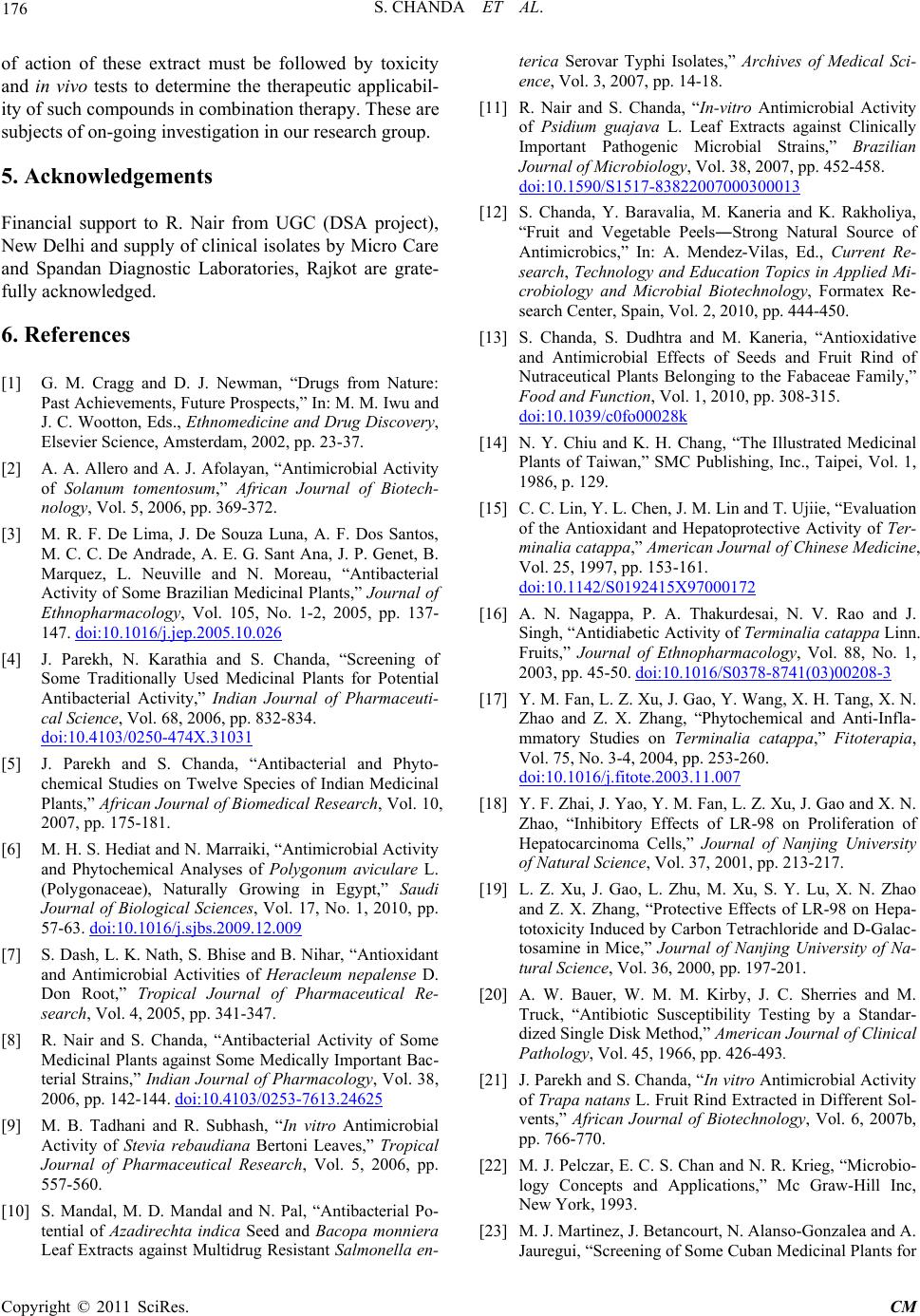
S. CHANDA ET AL.
176
of action of these extract must be followed by toxicity
and in vivo tests to determine the therapeutic applicabil-
ity of such compounds in combination therapy. These are
subjects of on-going investigation in our research group.
5. Acknowledgements
Financial support to R. Nair from UGC (DSA project),
New Delhi and supply of clinical isolates by Micro Care
and Spandan Diagnostic Laboratories, Rajkot are grate-
fully acknowledged.
6. References
[1] G. M. Cragg and D. J. Newman, “Drugs from Nature:
Past Achievements, Future Prospects,” In: M. M. Iwu and
J. C. Wootton, Eds., Ethnomedicine and Drug Discovery,
Elsevier Science, Amsterdam, 2002, pp. 23-37.
[2] A. A. Allero and A. J. Afolayan, “Antimicrobial Activity
of Solanum tomentosum,” African Journal of Biotech-
nology, Vol. 5, 2006, pp. 369-372.
[3] M. R. F. De Lima, J. De Souza Luna, A. F. Dos Santos,
M. C. C. De Andrade, A. E. G. Sant Ana, J. P. Genet, B.
Marquez, L. Neuville and N. Moreau, “Antibacterial
Activity of Some Brazilian Medicinal Plants,” Journal of
Ethnopharmacology, Vol. 105, No. 1-2, 2005, pp. 137-
147. doi:10.1016/j.jep.2005.10.026
[4] J. Parekh, N. Karathia and S. Chanda, “Screening of
Some Traditionally Used Medicinal Plants for Potential
Antibacterial Activity,” Indian Journal of Pharmaceuti-
cal Science, Vol. 68, 2006, pp. 832-834.
doi:10.4103/0250-474X.31031
[5] J. Parekh and S. Chanda, “Antibacterial and Phyto-
chemical Studies on Twelve Species of Indian Medicinal
Plants,” African Journal of Biomedical Research, Vol. 10,
2007, pp. 175-181.
[6] M. H. S. Hediat and N. Marraiki, “Antimicrobial Activity
and Phytochemical Analyses of Polygonum aviculare L.
(Polygonaceae), Naturally Growing in Egypt,” Saudi
Journal of Biological Sciences, Vol. 17, No. 1, 2010, pp.
57-63. doi:10.1016/j.sjbs.2009.12.009
[7] S. Dash, L. K. Nath, S. Bhise and B. Nihar, “Antioxidant
and Antimicrobial Activities of Heracleum nepalense D.
Don Root,” Tropical Journal of Pharmaceutical Re-
search, Vol. 4, 2005, pp. 341-347.
[8] R. Nair and S. Chanda, “Antibacterial Activity of Some
Medicinal Plants against Some Medically Important Bac-
terial Strains,” Indian Journal of Pharmacology, Vol. 38,
2006, pp. 142-144. doi:10.4103/0253-7613.24625
[9] M. B. Tadhani and R. Subhash, “In vitro Antimicrobial
Activity of Stevia rebaudiana Bertoni Leaves,” Tropical
Journal of Pharmaceutical Research, Vol. 5, 2006, pp.
557-560.
[10] S. Mandal, M. D. Mandal and N. Pal, “Antibacterial Po-
tential of Azadirechta indica Seed and Bacopa monniera
Leaf Extracts against Multidrug Resistant Salmonella en-
terica Serovar Typhi Isolates,” Archives of Medical Sci-
ence, Vol. 3, 2007, pp. 14-18.
[11] R. Nair and S. Chanda, “In-vitro Antimicrobial Activity
of Psidium guajava L. Leaf Extracts against Clinically
Important Pathogenic Microbial Strains,” Brazilian
Journal of Microbiology, Vol. 38, 2007, pp. 452-458.
doi:10.1590/S1517-83822007000300013
[12] S. Chanda, Y. Baravalia, M. Kaneria and K. Rakholiya,
“Fruit and Vegetable Peels―Strong Natural Source of
Antimicrobics,” In: A. Mendez-Vilas, Ed., Current Re-
search, Technology and Education Topics in Applied Mi-
crobiology and Microbial Biotechnology, Formatex Re-
search Center, Spain, Vol. 2, 2010, pp. 444-450.
[13] S. Chanda, S. Dudhtra and M. Kaneria, “Antioxidative
and Antimicrobial Effects of Seeds and Fruit Rind of
Nutraceutical Plants Belonging to the Fabaceae Family,”
Food and Function, Vol. 1, 2010, pp. 308-315.
doi:10.1039/c0fo00028k
[14] N. Y. Chiu and K. H. Chang, “The Illustrated Medicinal
Plants of Taiwan,” SMC Publishing, Inc., Taipei, Vol. 1,
1986, p. 129.
[15] C. C. Lin, Y. L. Chen, J. M. Lin and T. Ujiie, “Evaluation
of the Antioxidant and Hepatoprotective Activity of Ter-
minalia catappa,” American Journal of Chinese Medicine,
Vol. 25, 1997, pp. 153-161.
doi:10.1142/S0192415X97000172
[16] A. N. Nagappa, P. A. Thakurdesai, N. V. Rao and J.
Singh, “Antidiabetic Activity of Terminalia catappa Linn.
Fruits,” Journal of Ethnopharmacology, Vol. 88, No. 1,
2003, pp. 45-50. doi:10.1016/S0378-8741(03)00208-3
[17] Y. M. Fan, L. Z. Xu, J. Gao, Y. Wang, X. H. Tang, X. N.
Zhao and Z. X. Zhang, “Phytochemical and Anti-Infla-
mmatory Studies on Terminalia catappa,” Fitoterapia,
Vol. 75, No. 3-4, 2004, pp. 253-260.
doi:10.1016/j.fitote.2003.11.007
[18] Y. F. Zhai, J. Yao, Y. M. Fan, L. Z. Xu, J. Gao and X. N.
Zhao, “Inhibitory Effects of LR-98 on Proliferation of
Hepatocarcinoma Cells,” Journal of Nanjing University
of Natural Science, Vol. 37, 2001, pp. 213-217.
[19] L. Z. Xu, J. Gao, L. Zhu, M. Xu, S. Y. Lu, X. N. Zhao
and Z. X. Zhang, “Protective Effects of LR-98 on Hepa-
totoxicity Induced by Carbon Tetrachloride and D-Galac-
tosamine in Mice,” Journal of Nanjing University of Na-
tural Science, Vol. 36, 2000, pp. 197-201.
[20] A. W. Bauer, W. M. M. Kirby, J. C. Sherries and M.
Truck, “Antibiotic Susceptibility Testing by a Standar-
dized Single Disk Method,” American Journal of Clinical
Pathology, Vol. 45, 1966, pp. 426-493.
[21] J. Parekh and S. Chanda, “In vitro Antimicrobial Activity
of Trapa natans L. Fruit Rind Extracted in Different Sol-
vents,” African Journal of Biotechnology, Vol. 6, 2007b,
pp. 766-770.
[22] M. J. Pelczar, E. C. S. Chan and N. R. Krieg, “Microbio-
logy Concepts and Applications,” Mc Graw-Hill Inc,
New York, 1993.
[23] M. J. Martinez, J. Betancourt, N. Alanso-Gonzalea and A.
Jauregui, “Screening of Some Cuban Medicinal Plants for
Copyright © 2011 SciRes. CM